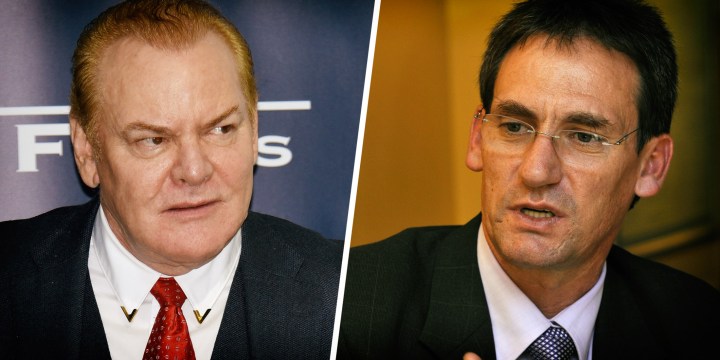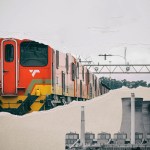BUSINESS MAVERICK ANALYSIS
Safety First: Gold Fields a natural destination for new CEO Chris Griffith

The Gold Fields that Chris Griffith will lead as CEO in April is very different from the company that Nick Holland steered from 2008. But Gold Fields’ global profile aside, Griffith steered Anglo American Platinum (Amplats) down a similar path, making it a natural destination for the former Anglo executive.
On the day that Nick Holland took over as CEO of Gold Fields on 1 May 2008 – Workers’ Day, no less – nine employees at the company’s South Deep mine west of Johannesburg were killed when the conveyance cage they were travelling in dislodged and plummeted more than 60 metres. With Holland due to retire on 1 April, it is of more than passing interest to read his first CEO message in the company’s 2008 annual report.
“[The South Deep] incident, together with several others through the year, brought the total number of deaths on our mines for the year to 47,” Holland wrote. “As I assumed office, it was clear to me that we had reached a watershed in our approach to safety and that my prime and immediate responsibility to employees, their families and shareholders was to demand a fundamental step change in our approach to safety. As a consequence, and with the full support of the Gold Fields Board, I announced on 7 May 2008 that we will not mine if we cannot mine safely. While the short-term impact of this policy will come at a high cost, I am confident that the long-term gains will substantially benefit our employees and shareholders alike.”
After the announcement last Thursday that Chris Griffith would be his replacement, Holland told reporters and analysts on a conference call: “We as executives all have sleepless nights about safety … I am really pleased that we have improved on safety.”
In the 2019 annual report, one fatality was recorded at its operations, that of Maria Ramela, a trackless crew leader at South Deep. Holland once told this correspondent that he had fired senior staff for not taking safety seriously. His demeanour is no-nonsense and he meant business.
Griffith became CEO of Amplats in 2012, reportedly because his predecessor had been fired over his safety record. Seven of the company’s employees were killed on the job that year.
“I will continue to do everything I can to ensure that we remain steadfast in our commitment to achieving zero harm,” Griffith said in his first CEO message in the 2012 annual report. In 2019, the company recorded the first calendar year that saw no employees killed at the operations it manages.
Another revealing metric is the Total Recordable Case Frequency Rate (TRCFR) per million hours, which records any injury requiring more than first aid treatment. In its interim results for 2020, Amplats had a TRCFR of 2.24, down 50% from 2017.
Neither executive would declare “mission accomplished”. But the improvements are massive. And the preservation of human lives is clearly the ultimate social dividend.
This is part of a wider South African drive to safer mining. Statistics from the Minerals Council South Africa, the main body representing the industry, show that between 1993 and 2019 fatalities in the industry fell 93%, from more than 600 to 51.
And the two companies followed parallel paths on this journey. Both made a hard pivot to mechanisation and automation. Gold Fields spun off its labour-intensive South African operations into a new entity, Sibanye Gold, now also a platinum group metal (PGM) producer called Sibanye-Stillwater. Amplats would do something similar, selling the bulk of its labour-intensive assets to Sibanye while pouring resources into technical research and development.
Mechanisation and automation effectively enable machines to carry out tasks that humans once did in highly dangerous circumstances, such as drilling and bolting. This trend will accelerate wherever South Africa’s challenging geology allows. Digital initiatives also hold out huge promise on the safety front. And more archaic technology has been rolled out in the service of safety, such as netting to prevent crushing rock falls. Mineworkers can also refuse to enter an area they feel is dangerous, for whatever reason, without fear of HR coming down on them like a fall of rock. These and other measures have also helped to make conventional mining much safer. In a related trend, strides have been made in health outcomes across the industry, with fewer mine workers contracting fatal occupational diseases such as silicosis.
Holland was also at the forefront of underreported efforts to phase out Fanagalo as the lingua franca of South Africa’s mines. It is still heard in the shafts of some companies, but is far less common and was years ago banned at Gold Fields.
Mechanisation and other technical developments also lead to job losses. Lives are saved, but livelihoods are lost, to use the trade-off lingo of our times. But they also create higher-skilled and better-paying jobs that can be done safely while raising productivity – and profits. Holland was not wrong when he asserted in 2008 that “the long-term gains will substantially benefit our employees and shareholders alike”.
These trends are the product of a range of factors. Technology is clearly one as the pace of technical advancement continues to accelerate. Successive ANC administrations since 1994 have also put pressure on the industry to clean up its safety act. At times over the years, the sector has complained – and often not baselessly – that regulators have been overzealous in halting operations over hazardous incidents or alleged safety violations. But it clearly focused minds. Unions as well have played a role in pushing for safer working conditions for their members.
Investors have also played a role, a point this correspondent and many others have made before. Fund managers were flagging safety concerns years ago as a deterrent to investment in South Africa’s mining sector. This coincides with changing currents in public attitudes. Think, for example, of the Black Lives Matter movement. One could perhaps say that a variant on this is “Miners’ Lives Matter”, and in the South African context, the majority are black. It is a far cry from the apartheid era, when hundreds died each year underground and the lives of black mineworkers clearly did not matter in white boardrooms.
When Holland and Griffith were fielding questions last Thursday, environmental, social and governance issues (ESGs) were a common theme. Griffith and Holland both made ESGs centrepieces of the way their companies did business. It is often easy to dismiss such things as corporate whitewashing or greenwashing or what have you, which it no doubt is in many cases. Historians decades from now might look back and, with the benefit of hindsight, see it all as a gigantic scam. But the vastly improved safety record tells a different story, as do many other shifts in corporate culture, such as commitments to cut carbon emissions and move to green energy sources. And it is fast becoming embedded in business. A report released this month by global consultancy PwC found that 95 of the roughly 340 companies listed on the JSE have disclosed performance links to JSE measures.
Holland was also at the forefront of underreported efforts to phase out Fanagalo as the lingua franca of South Africa’s mines. It is still heard in the shafts of some companies, but is far less common and was years ago banned at Gold Fields. A pidgin language, it mostly consists of commands with some obscenities thrown in for good measure, according to people familiar with it. In short, it is a language of disrespect, and getting employees to respect and treat one another with dignity after the indignities of the apartheid past is a significant accomplishment.
It must also be said that more hard-headed factors have been at play in developments such as the swing to mechanisation. Social and labour unrest is one. Its roots lay in the colonial and apartheid eras, when the wages of the migrant mine labour force remained stagnant and even declined over the course of decades. Since the 1970s and especially over the past couple of decades, the wages of mine workers soared, but from a pathetically low base. Rising wages, along with power prices and deeper shafts, have significantly added to the industry’s costs. And the explosion of violent strikes, many of the wildcat variety, which was detonated by Amcu’s rise on the platinum belt, clearly caused tremors in the boardroom. The Marikana massacre of 2012, when police shot dead 34 Lonmin strikers, was a “mechanisation” moment for the industry.
For the platinum Industry, Marikana was a ‘Mechanisation Moment’
Mechanisation has also undermined the power of labour vis-a-vis capital, as 2019’s moderate wage settlements in the PGM sector underscored. This is an inadvertent consequence of the process, it is true. It can also be intentional. It’s called de-risking your profile, to use the corporate jargon. Gold Fields did this by not only ditching its labour-intensive operations in South Africa, but by also moving most of its production base outside of the country. In fairness, this geographical transition was also a response to policy uncertainty and changing goalposts, the unreliability of Eskom and its surging bills, rampant crime including the theft of gold by illegal miners and later armed gangs, the mounting security costs this called for, and the deep depths of new ore bodies. In short, geology aside, shoddy and even predatory ANC governance deserves a lot of the blame here. Moving production offshore was not really an option for Amplats as PGMs are mostly found in South Africa. The other big deposits are mostly found in Zimbabwe, where Amplats operates, and Russia. Acquiring new assets in such jurisdictions is hardly going to de-risk your profile.
Is “de-risking” in this context an indictment? It would depend on your perspective. Down the road, we might look back in astonishment at the fact that rock-driller operators were plying their pounding and dangerous trade 4 kilometres beneath the surface. But it does raise the question of how, in a country with an unemployment rate that is effectively north of 40%, you stuff the round peg of mechanisation into the ESG board. Is this hole round or square-shaped?
The in-box for Griffith at Gold Fields includes the $860-million Salares Norte project in Chile. Construction of the mine, scheduled to be completed in late 2022, began this month. Griffith has a reputation for thinking outside the box, and he comes equipped with a highly technical cast of mind forged at Amplats. The problems at South Deep certainly call for some deep technical thinking.
And with the gold price north of $1,800 an ounce, it’s not a bad time to run a gold operation. Then again, rhodium recently scaled record highs over $20,000 an ounce. Being at the helm of a PGM producer is no bad thing either. Just ask Neal Froneman, the CEO of Sibanye, which played a role in the journey of both companies. His company is now producing both gold and PGMs, including from “de-risked” places such as the US state of Montana. DM/BM


















 Become an Insider
Become an Insider
The Industry and the GME can thank Cynthia Carrol, while CEO of Anglo American, for the dramatic change in the attitude to Safety in our Mines.